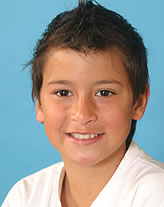NCIP Paediatric Programme
What is a cochlear implant?

- External speech processor captures sound and converts it to digital signals.
- Processor sends digital signals to internal implant.
- Internal implant turns signals into electrical energy, sending it to an array inside the cochlea.
- Electrodes stimulate hearing nerve, bypassing damaged hair cells, and the brain perceives signals; you hear sound.
Cochlear implants aim to provide useful hearing to children who get little or no benefit from hearing aids. Implants consist of an external speech processor and an internal component.
The visible component of the cochlear implant is called the processor. It consists of a microphone, batteries and a mini computer that analyses incoming sounds and converts them into digital signals. These signals are then transmitted through the skin via a coil to the internal implant via radio waves.
The internal implant is designed to bypass damaged parts of the inner ear and send electrical stimulation directly to the auditory nerve which the brain interprets as sound.
A cochlear implant may benefit your child if:
- A severe to profound hearing loss has been diagnosed and hearing aids are not effective enough
- Your child has a significant hearing loss from recent meningitis
- Your child’s hearing is getting worse
- Your child has auditory neuropathy spectrum disorder and his/her speech and language development is not progressing as expected
It is important to note that just because your child fits the categories above it does not mean they will be a good candidate for an implant.
Advantages of a Cochlear Implant
- Most recipients can follow a normal conversation and participate more easily in the hearing community.
- Allows many children with profound hearing loss to achieve age-appropriate speech and language.
- May enable use of the telephone.
- Avoids problems with acoustic feedback and ear moulds.
- Can detect soft environmental sounds across the frequency range 250Hz-8KHz.
- Enables greater ease with high frequency consonant perception and production e.g. /s/ /sh/ /f/ /t/ /k/ /p/ /h/ /th/.
Disadvantages of a Cochlear Implant
- Requires significant time commitment to habilitation following surgery.
- Residual hearing in the implanted ear may be lost as a result of the surgery.
- The speech processor must be protected against moisture during water activities (such as swimming, bathing or showering). The cochlear implant may need to be removed for water activities, or alternatively, water protective covers may be used.
Surgery
An operation lasting for two to three hours is necessary to insert the implant. After surgery, patients usually stay overnight and go home the next day. The surgical process is explained in detail during each child’s assessment. A parent stays overnight with the child.
What do I do next?
If you have not been referred and you would like your child to be assessed for a cochlear implant, contact the following groups:
Northern Cochlear Implant Programme (Taupo North) Clinical Services Coordinator on 09 579 2333 or 0800 254 783 or , or your local Ear Nose & Throat Specialist or Audiologist.
Southern Cochlear Implant Programme (South of Taupo) Programme Administrator on 0800 500 405 or , or your local Ear Nose & Throat Specialist or Audiologist.
Life after a cochlear implant

“Ella is soooo happy to have her implant and that she can’t believe that she lived her life without one! Everyday is about discovery! … We have never had any regrets. Ella knows that it is only going to get better but already the benefits are amazing.”
Life after a cochlear implant

“Elizabeth is now interpreting sounds and recognising words, which is so exciting for us. One of the neat things is she will listen to music and will turn it on again when it is finished, showing us she is recognising sound. It is especially exciting, given that she has Down Syndrome, for her to have the opportunity to assist her to reach her potential.”
Life after a cochlear implant

“The cochlear implant has given Matthew the gift of being able to hear, listen and speak. This has opened up a world of options that may not have been accessible to Matthew otherwise.”